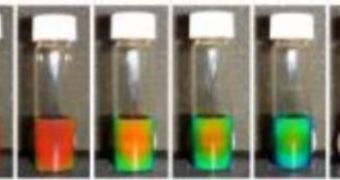Nanotechnology is full of surprises and new applications are discovered every day. One of the most unusual is the recent experiment of a team of scientists who were able to make a magnet change the color of a liquid, turning it from coffee-brown to orange, then green and finally dark blue.
The liquid is actually a solution of iron oxide in water and this is the first time anyone has proven such a strange effect of magnetism. Yadong Yin, an assistant professor of chemistry at the University of California, Riverside, led the research and said that there are many possible applications for this technique in the near future.
"What should make the technology commercially attractive is that iron oxide is cheap, non-toxic and available in plenty" Yin said. The phenomenon could be used in electronic displays, whose picture quality in size could be greatly improved and also in rewritable electronic paper, using ink that changes color using electromagnets.
The already available electronic paper uses thin layers of steel topped with another layer of circuits, then a thin film of digital ink and future applications will allow hundreds of books to be downloaded onto them via the Internet and newspapers that constantly update the articles.
The explanation of the strange color changing phenomenon is the fact that when the intensity of the magnetic field is changed, the tiny spheres of iron oxide in the solution change their arrangement, which in turn modifies the way light falls on the particles, passing through or being reflected.
"The key is to design the structure of iron oxide nanoparticles through chemical synthesis so that these nanoparticles self-assemble into three-dimensionally ordered colloidal crystals in a magnetic field," said Yin.
Iron oxide nanospheres form photonic crystals, which are the reason why light behaves differently when hitting the liquid. "By reflecting light, these crystals show brilliant colors," Yin said. "Ours is the first report of a photonic crystal that is fully tunable in the visible range of the electromagnetic spectrum, from violet light to red light."
Another possible application of the photonic crystals are the cheap color displays, produced by arranging the crystals into millions of small pixels that change color when placed in a magnetic field.
"A different color for each pixel can be assigned using a magnetic field," he said. "The advantage is that you need just one material -- for example, photonic crystals like iron oxide -- for all the pixels. Moreover, you don't need to generate light in each pixel. You would be using reflected light to create the images -- a form of recycling."

 14 DAY TRIAL //
14 DAY TRIAL //